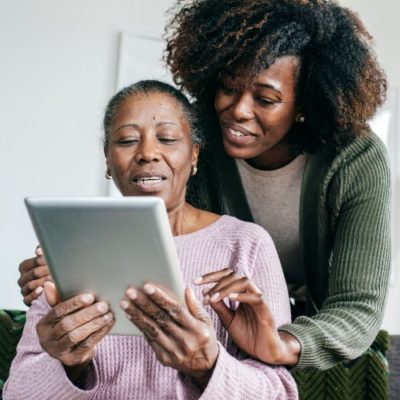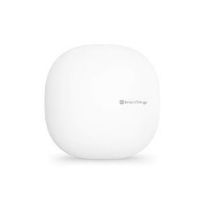Smart home technology goes beyond convenience. Hands-free and app-controlled devices can make living at home safer and easier for older adults who have a hard time getting around or remembering schedules.
Smart home technology helps users customize devices based on their schedules and preferences. The best smart tech links devices together into a full network.
Within a network, you can set up automations that trigger devices in sequences. For example, when a motion sensor in the hallway detects movement, it can turn on the bathroom light. Or it can set the door lock on a timer to let a caregiver in.
Whether loved ones live nearby or far away, smart home systems can make life easier for older adults and the people who care about them.
Elder Care in the Time of COVID-19
How a Smart Home System Can Help Aging Parents
1. Simpler Daily Routines
Smart home devices can work together to make the morning a little brighter. Linking together smart hubs and accessories takes only a few minutes, and you reap the benefits long after.
Older adults can program devices according to their preferences and schedule, from setting medicine reminders to lighting dim hallways.
Smart Home Hubs
A smart home hub is the “brain” that connects all your devices together. They can save an extra trip to turn off a light or make turning on appliances easier for anyone with limited mobility.
The best smart home systems work with third-party devices and smart speakers. They’re also easy to control through a mobile app on your Android or iPhone.
Smart speakers like an Amazon Echo or Google Home can double as smart home hubs. These speakers use voice control, minimizing frustration for those less comfortable with apps. Alternatively, you can choose dedicated hubs like the Samsung SmartThings.
Samsung SmartThings is compatible with hundreds of devices that you may already have and even comes with a few of its own. It can connect with video cameras for live streaming, motion detectors, door and window sensors, lights, and smart plugs to simplify your daily routine.
Smart Lighting and Appliances
No need to fumble in the dark when nature calls in the middle of the night. Instead of risking injury on your way to the next room, you can activate smart light bulbs with voice commands or through a mobile app.
Smart plugs turn ordinary appliances like lamps, coffee makers, or stereos into smart technology you can control with your voice or an app. So you can program your coffee maker to start in the morning and set your lamps to turn on when you come home at night.
Smart light bulbs and plugs are affordable (usually under $50) and can help out older adults with needs related to mobility, memory, or vision impairment.
2. Hands-Free Control
Conditions like arthritis can make it painful to press buttons or adjust dials. Investing in smart tech devices and automations with hands-free or voice control makes daily tasks less draining.
Smart Speakers and Virtual Assistants
Amazon Echo and Google Home smart speakers are more than just clever hunks of plastic. They can act as their own smart hubs, connecting tons of devices throughout the house. Virtual assistants (think Alexa and Siri) are helpful voices inside that can speak to older adults and follow commands with a simple, “Hey Alexa.”
Smart speakers offer plenty of uses:
- Set reminders for appointments and meds
- Call loved ones and caregivers
- Answer questions
- Share recipes
- Play music, audiobooks, and the news
- Activate smart devices
Program a Morning Routine
3. Smarter Safety and Security
Safety and security at home are important no matter how old you are. Home automation and smart home devices have made it easier than ever to protect your home. Here are some simple, effective systems that react quickly in an emergency.
Security Systems
Home security systems provide home automation to protect from intruders, fires, and flooding. Most of these systems come with door and window sensors, motion detectors, and a smart hub, but you can add on more based on your needs.
We like systems like Frontpoint and Vivint for older adults seeking assistance. These brands come with professional monitoring. When an emergency arises, the pros are on the case and call to check on you.
Smart Locks and Sensors
Smart door locks keep your front door secure whether you’re home or away. Most link to an app on your phone that shows the lock’s status, so you can lock and unlock the door while you’re out of the house.
These can come in handy for older adults who may lose their keys often or forget to lock and unlock the door.
You can add authorized users for regular visitors like at-home nurses, spouses, or other caregivers. These users can also lock, unlock, and check the door’s status using tools like apps, keypads, Bluetooth tech, or other keyless methods.
Medical Alert Systems
There’s a lot to love about living alone and being independent, but even healthy older adults aren’t immune to accidents and emergencies. A medical alert system can connect to caregivers and emergency services in case of a fall, heart trouble, or other serious situations.
These devices come as wearables that can be taken anywhere (even in the shower in case of slips). Or you might choose to place them around the house as emergency buttons.
4. Cleaner, More Comfortable Home
For some older adults, keeping up the house can become a challenge. We’ve found a few smart home devices that make aging in the home much easier, cleaner, and more comfortable.
Robot Vacuums
Robot vacuums may seem futuristic, but they’re nothing new. These smart gadgets clean, sweep and suck up debris from tile, hardwood floors, and carpet without you needing to lift a finger. They have onboard sensors that can tell where walls and stairs are, so they can avoid obstacles and keep up their pace.
Smart Thermostats
With a smart thermostat, you don’t need to get up to turn on the air conditioning or heat. Just like other smart home devices, these clever gadgets can be controlled with your voice or through an app on your phone. The best part is, they can save you money on your monthly energy bill.
Smart Home FAQ
Can caregivers monitor smart home tech remotely?
Yes. Most smart home devices allow more than one user to control and monitor functions through the app.
This way, you can give control to your loved one and download the app on your phone to check on them. This is a great feature to have in smart cameras, security systems, medical alert systems, and smart locks.
Are smart home devices easy to install?
Yes. Many of the devices we mentioned in this article just need Wi-Fi and some time on the mobile app to set up. DIY home security systems, for example, come with sticky backings for sensors. So if you can peel a sticker, you can set up a home security system.
I live far from my aging parents. Can smart home devices help me care for them?
It’s hard to live far away from your parents, especially as they get older. But smart home devices in their home can keep you connected and updated on how they’re doing. While it depends on the device, gadgets like smart cameras can live stream video to multiple users via mobile apps.
Medical alert devices, too, let you list yourself as a caregiver or emergency contact in case something happens.
The post How Smart Home Tech Can Help Older Adults appeared first on SafeWise.
Article source here: How Smart Home Tech Can Help Older Adults



No comments:
Post a Comment